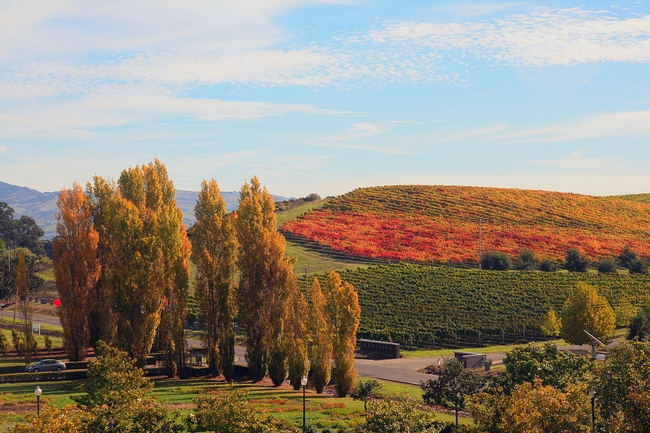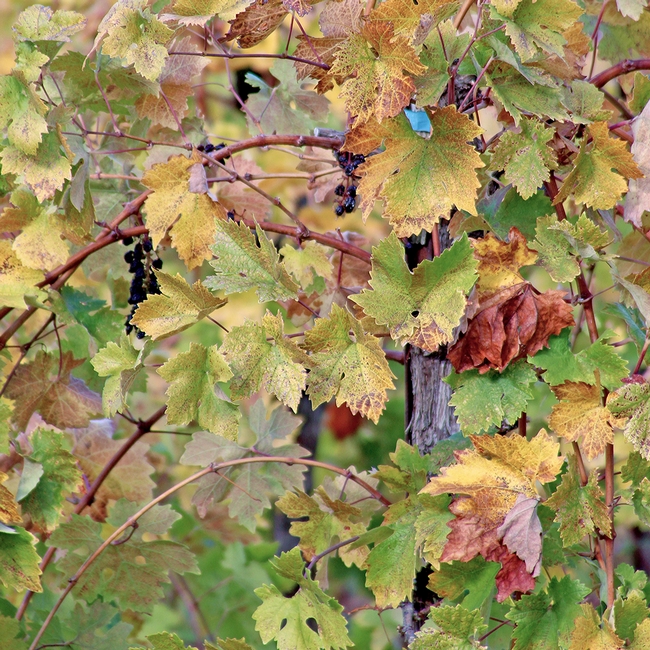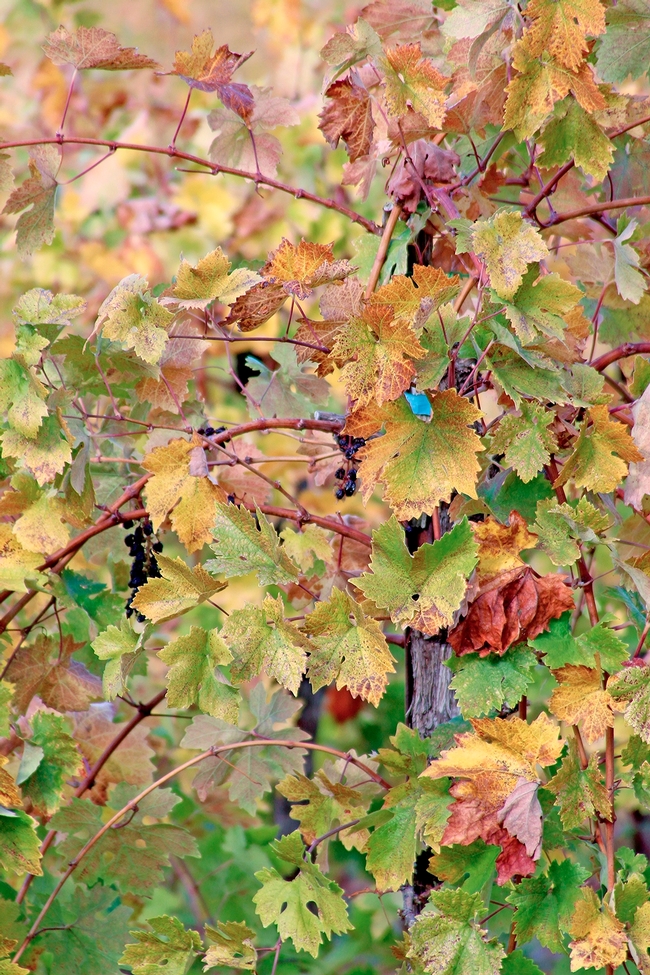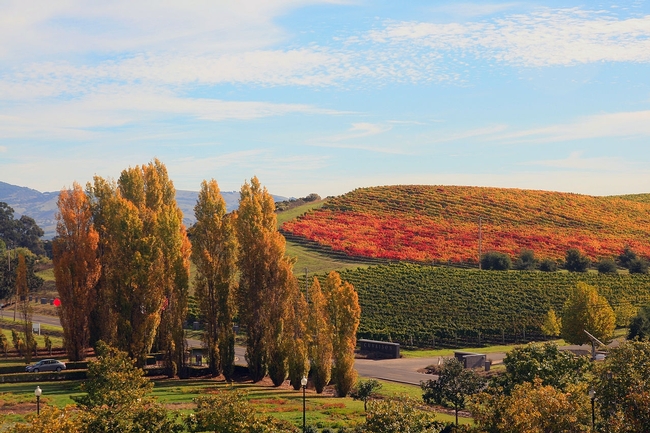Posts Tagged: red blotch
Grape experts give workshops on drought preparedness, red blotch
Grape growers and other industry members interested in grape production and water management in vineyards are invited to UC Cooperative Extension's Grapevine Drought Preparedness Workshops.
The workshops will be held in person on Friday, March 4, in San Luis Obispo and Friday, April 1, in Hopland.
Registration is $50 and includes a full day of live instruction from UC Cooperative Extension viticulture and grapevine experts. Lunch will be provided.
For more information and to register, visit https://ucanr.edu/sites/ShortCourse17.
UC Davis Grapevine Red Blotch Disease Symposium
On Wednesday, March 16, UC Cooperative Extension and the UC Davis Department of Viticulture and Enology will host a Grapevine Red Blotch Disease Symposium 9 a.m.-3:30 p.m.
Red blotch disease in grapevines, which can dramatically reduce the value of winegrapes, harms plants by inhibiting photosynthesis in the leaves. Infected vines are unable to conduct water effectively, leaving sugar that is created by photosynthesis stuck in the leaves instead of in the berries.
This event will be presented both in person at the UC Davis Conference Center and livestreamed for those unable to attend in person.
Presentations will cover the role of treehoppers, treatments, mitigation strategies, the impact of the disease on the composition of wine, and more.
Registration is $250 for the in-person symposium at UC Davis and $150 for the livestream. An application for 3.5 CCE units has been submitted to California Department of Pesticide Regulation and is pending approval.
To see the agenda and to register, visit https://wineserver.ucdavis.edu/events/uc-davis-grapevine-red-blotch-disease-symposium.
UC researchers discover how grapevine red blotch virus diminishes winegrape value
Grapevine red blotch virus, a disease that is dramatically reducing the value of winegrapes in California's premium wine production region, is harming plants by inhibiting photosynthesis in the leaves, according to research published this month in the Journal of Agricultural and Food Chemistry.
The new research also showed that infected vines weren't able to conduct water effectively, leaving whatever sugar that was created by photosynthesis stuck in the leaves. The accumulation of sugar in the leaves results in reduced sugar in the berries and lower-quality wine, said UC Cooperative Extension specialist Kaan Kurtural, one of the study authors.
According to the report, sucrose and its monosaccharides were the vast majority of soluble sugars found in the leaves. The leaf sugar tended to decrease in the ripening process on red blotch negative vines. But this was not the case in red blotch positive vines. As a result, grapevines infected with the virus produce winegrape clusters with reduced sugar content, poor color development and increased acidity.
Kurtural said the research will inform winegrape growers as they consider possible treatments in vineyards with grapevine red blotch-infected vines.
“There are some treatments that are being offered to growers, but now that we better understand the disease, we know they won't help,” Kurtural said. “Growers don't have to replace the infected vineyards immediately. But if 40 percent of vines are infected, they may want to consider replanting. At least now we know what the disease does, so they won't pay for snake oils.”
Grapevine red blotch virus was first discovered in the Oakville Experiment Station, UC Davis' research vineyard in Napa Valley, in 2008. Since then, researchers found the virus in grapevines throughout California and in 11 other states.
For the new research, the scientists compared naturally infected winegrape vines at the Oakville Station on two rootstocks – 110 R and 420 A – with vines grown on those two rootstocks that were not infected. Grape clusters were collected to examine differences in berry weight, titratable acidity, pH and total soluble solids.
“All those characteristics are important for wine quality,” Kurtural said. “Acidity and pH effect palatability and storage potential. Berry weight and soluble solids impact the physical characteristics of the wine.”
The grapevine red blotch virus impact on anthocyanidins and tannins are a still greater concern for winegrape growers as they change the flavor profiles sought in premium wines.
“High-value winegrapes are sold between $7,000 to $23,000 a ton. If the winegrapes don't have the profiles that wine makers are looking for, they may only be valued between $1,500 to $2,000 per ton,” Kurtural said.
The research was conducted by UC Davis post-doctoral students Johann Martinez-Buscher, Cassandra Plank, Runze Yu and Luca Brillante in collaboration with Kurtural, UCCE viticulture specialist Anita Oberholster, UCCE advisors Monica Cooper and Rhonda Smith and UC Davis Foundation Plant Services academic administrator Maher Al-Rwahnih.
Researchers suspect leafhopper may be spreading red blotch

In 2008, UC Cooperative Extension specialist Jim Wolpert and staff research associate Mike Anderson identified red blotch as a disease caused by a distinct virus. Since then, it has been found in numerous California regions, as well as 11 other states, including all major U.S wine states.
As suggested by its name, the disease turns grape leaves a blotchy red color. The infected grapevines may produce clusters with reduced sugar content, causing delayed harvests. Poor color development and increased acidity are found in some clusters on diseased vines. There is no cure.
The Wine Spectator article said UC Davis and USDA Agricultural Research Service may have made a breakthrough in understanding how the disease is spread. After running experiments with various insects found in infected vineyards, they theorize that the three-cornered alfalfa treehopper is a probable vector for the disease. Greenhouse-raised, disease-free control vines were found to have contracted red blotch after exposure to treehoppers from infected vineyards.
The treehopper mostly feeds on plants near vineyards — fruit trees and grasses. It sometimes feeds on leaves, but was considered a minor pest. If the treehopper is the disease vector, farmers will have a target for treatments that could slow the spread of red blotch.
"Management strategies so far have relied exclusively on careful selection of clean planting materials from virus-tested stocks," said Marc Fuchs of the School of Integrative Plant Science at Cornell University. "So the identification of the three-cornered alfalfa treehopper as a vector is putting researchers in a position to develop more effective management strategies."
Fall colors in wine country are not a picture of health

In 2008, a disease characterized by red blotches along leaf margins and red veins under the leaf surfaces was seen in red grapes growing in Napa Valley. The symptoms resembled leafroll disease, however laboratory tests did not detect any leafroll and rugose wood viruses in the samples. Since then, red blotch disease has been observed in vineyards throughout North America.
The infected grapevines may produce clusters with reduced sugar content, causing delayed harvests. Poor color development and increased acidity are found in some clusters on diseased vines.
A virus associated with red blotch disease was identified in 2012. The incidence of the red blotch disease relative to other virus diseases is currently not known, according to the UC IPM Pest Management Guidelines. The guidelines, produced by UC Agriculture and Natural Resources' (UC ANR) Statewide Integrated Pest Management Project, offer comprehensive information free online for pest control in more than 50 California crops.
UC ANR Cooperative Extension specialist, Deborah Golino, director of Foundation Plant Services at UC Davis, wondered if the virus associated with red blotch disease was new to California. She turned to the UC Davis Herbarium, a repository of 300,000 pressed plant samples, including grapevines dating back to 1940.
Golino and her laboratory staff collected 56 samples and, to prevent contamination, tested them in a lab that only works with lettuce. Of the 56 samples, one, an early burgundy collected in Sonoma County, was positive.
“We have confirmed that red blotch disease is not new,” Golino said. “It's been around at least since 1940.”
The results were published this year by the American Phytopathological Society in the journal Plant Disease.
An initiative to manage endemic and invasive pests and diseases is part of UC Agriculture and Natural Resources Strategic Vision 2025.
New technology offers hope for solving grapevine red blotch disease

The virus is of particular concern to wine grape growers, whose grapes must reach a certain sugar content level before they are suitable for winemaking.
"The most urgent research need now is to determine how the virus spreads," said Deborah Golino, UC Cooperative Extension specialist in the Department of Plant Pathology at UC Davis and director of the UC Davis-based Foundation Plant Services.
"Due to the distribution of the virus in many parts of the United States and evidence that it can be transmitted by grafting, we suspect that red blotch disease is widespread wherever grapes are grown," Golino said.
Golino encouraged vineyard owners and managers to evaluate their vineyards for red blotch disease as they would for any other viruses.
Symptoms include blotches of pink or red veins on green leaves in the fall, when grape leaves would normally be turning a uniform gold color. Growers also might notice that their grapes are slow to develop sugar levels sufficient for winemaking, with some grapes never fully maturing.
"If there are visual signs of red blotch, as well as poor sugar development, growers should test their vines for both red blotch and leafroll virus because the symptoms of the two viruses are so similar," Golino said.
She reported that red blotch disease has been identified among both young and mature grape vineyards in California, New York, Virginia, Maryland, Pennsylvania, Texas and Washington. A virus almost genetically identical to red blotch also was found in Canada.
While the virus, also called grapevine red blotch-associated virus or GRBaV, likely can be found in all types of grapes, including rootstock, and table and raisin grapes, it was first detected in wine grapes because they are carefully monitored for sugar content to determine harvest date.
Presence of the virus in a vine can be confirmed using an extremely sensitive laboratory test known as polymerase chain reaction, or PCR, to detect small amounts of genetic material. This analytical process uses an amplification technique that multiplies the existing DNA and similar genetic material to identify the virus.
"If the vineyard tests positive for red blotch, the grower needs to decide, from an economic standpoint, when is the best time to remove the diseased vines and replant the vineyard," Golino said. "This is always a complex decision, and there is no one-case-fits-all answer."
Golino said that the Foundation Plant Services' Classic Foundation vineyard block, used for producing disease-free scion and rootstock vines, has been partially tested and appears to have a very low-level incidence of red blotch virus. Only three of the 1,600 vines tested to date were found to have the virus. Testing of all of the vines in the Classic Foundation vineyard, the source of the majority of grapevine nursery stock in California, is slated for completion in the months to come.
"The good news is that our new Russell Ranch Foundation Vineyard block has been tested, and there is no sign of red blotch virus in any of those vines," Golino said. This vineyard is propagated exclusively with vines that have been through tissue-culture therapy to exclude red blotch and other viruses. Test records from the Foundation Plant Services vineyards are available at http://fps.ucdavis.edu.
Golino cautioned that many more new viruses and other microbes are likely to be found in grapevines in the next few years, thanks to powerful new DNA sequencing technology.
"Some of those will be disease agents, some beneficial, and some neutral," she said. "We will have our work cut out for us in understanding the role of these microbes, but the ultimate result will be increased ability to create superior vineyards."
"The appearance of red blotch virus underscores the vital importance of the Foundation Plant Services and adequate funding for USDA's National Clean Plant Network," said John Aguirre, president of California Association of Winegrape Growers. "Growers need clean plant material to meet winery demands for increased winegrape production and improved quality."
Golino said that progress on identifying and characterizing red blotch has been a collaborative effort between many university-based researchers over the years.
Red blotch disease was first recognized in 2008 in a Napa Valley vineyard by Jim Wolpert, a UC Davis-based Cooperative Extension viticulturist, and Mike Anderson, a viticulture researcher and manager of UC Davis' Oakville Experiment Station.
Two UC Davis scientists - Mysore Sudarshana , a U.S. Department of Agriculture researcher in the plant pathology department, and Maher Al Rwahnih, a researcher at Foundation Plant Services - teamed up in an effort to identify the virus causing red blotch disease. Al Rwahnih was an early user of next-generation, or high-throughput DNA sequencing technology.
During today's meeting, Golino announced that California rootstock nurserymen acted last week to assist the California viticulture industry with research addressing GRBaV. The California Grape Rootstock Research Foundation, which funds research to enhance California viticulture and the grape nursery industry, has agreed to provide seed money to jumpstart research on the virus.
More information on red blotch disease is available on the University of California Integrated Viticulture website.
Foundation Plant Services is a self-supporting unit of the College of Agricultural and Environmental Sciences at UC Davis. The service, dedicated to the distribution of disease-tested, true-to-identity plant materials produced by UC researchers, plays a key national and international role in distributing new crop varieties and healthy planting stocks.
About UC Davis
For more than 100 years, UC Davis has engaged in teaching, research and public service that matter to California and transform the world.
Located close to the state capital, UC Davis has more than 33,000 students, more than 2,500 faculty and more than 21,000 staff, an annual research budget of nearly $750 million, a comprehensive health system and 13 specialized research centers. The university offers interdisciplinary graduate study and more than 100 undergraduate majors in four colleges -- Agricultural and Environmental Sciences, Biological Sciences, Engineering, and Letters and Science. It also houses six professional schools -- Education, Law, Management, Medicine, Veterinary Medicine and the Betty Irene Moore School of Nursing.
Media contacts:
- Deborah Golino, Foundation Plant Services, (530) 754-8102, dagolino@ucdavis.edu
- Pat Bailey, UC Davis News Service, (530) 752-9843, pjbailey@ucdavis.edu


